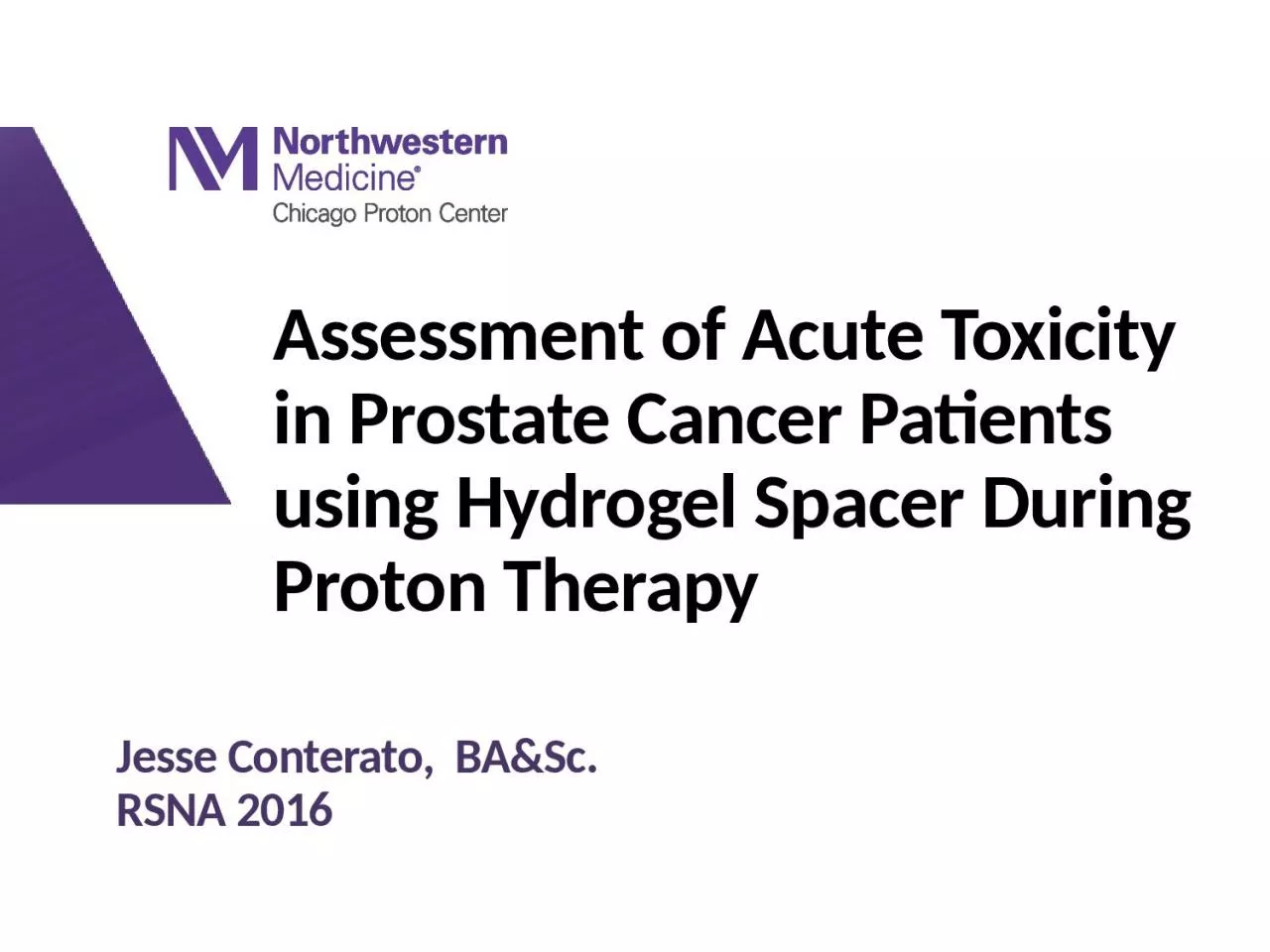

Jesse Conterato BAampSc RSNA 2016 Hydrogel Spacers MRI Comparison Axial View Sagittal View Pinkawa et al WJCO 2015 Without Spacer With Spacer Absorbable polyethylene glycol hydrogel spacers are injected into the ID: 932445
Download Presentation The PPT/PDF document "Assessment of Acute Toxicity in Prostate..." is the property of its rightful owner. Permission is granted to download and print the materials on this web site for personal, non-commercial use only, and to display it on your personal computer provided you do not modify the materials and that you retain all copyright notices contained in the materials. By downloading content from our website, you accept the terms of this agreement.
Slide1
Assessment of Acute Toxicity in Prostate Cancer Patients using Hydrogel Spacer During Proton Therapy
Jesse Conterato,
BA&Sc
.
RSNA 2016
Slide2Hydrogel Spacers: MRI Comparison
Axial
View
Sagittal
View
Pinkawa
et al. WJCO 2015
Without Spacer
With Spacer
Absorbable polyethylene glycol hydrogel spacers are injected into the peri-rectal space.Moves the anterior rectal wall outside of high dose volumes
Hydrogel Spacer
Rectum
Prostate
Slide3Hydrogel Spacers During Proton Therapy?
Prospective IMRT trials demonstrate advantage of h
ydrogel spacer during
treatment for prostate cancer:
Rectal dose reductionSeverity of rectal toxicity reduced(Song et al. 2013, Mariados et al. 2015, Uhl
et al. 2014)3
Few studies have examined the use of hydrogel spacers in patients treated with proton therapy
Mariados
et al.
Int
J Radiation
Oncol
Biol Phys 2015
Slide4Purpose
To evaluate the acute toxicity outcomes in prostate cancer patients treated with definitive proton beam radiotherapy (PBRT) with a hydrogel spacer (HS) in place
Slide5Methods
Retrospective review of prostate cancer patients undergoing definitive PBRT at a single institution
Patient data collected from:
Prospective Proton Collaborative Group Registry
Our institutional Advancements Through Outcomes Measures protocol63 consecutive patients with hydrogel spacer in placeTreatment era: April 2015 – February 2016All patients completed treatment of 79.2 Cobalt Gray Equivalent (CGE) in 44 fractionsAcute Toxicity was defined as occurring during the PBRT treatment period
5
Slide6Methods and Patient Characteristics
Toxicity was prospectively assessed weekly during PBRT and scored according to CTCAE v4.0 in 6 genitourinary (GU) and 4 gastrointestinal (GI) categories:
GU: Urinary Tract Pain, Urinary Frequency, Urinary Retention, Urinary Incontinence, Urinary Urgency, Hematuria
GI: Fecal Incontinence, Rectal Hemorrhage,
Proctitis, and Diarrhea.6
Slide7Methods and Patient Characteristics
7
Slide8Results: Spacer Placement Safety
No infections were observed after hydrogel injection, performed under trans-rectal ultrasound guidance
8
Müller et al.
Radiol
Oncol 2016
Prostate
Prostate
Prostate
Prostate
Slide9Results: Overall GU Toxicity
Most common forms of Grade 2 GU toxicity:
Urinary frequency, retention, and urgency
Grade 3 GU toxicity:During PBRT, one patient experienced GR3 urinary tract pain while being treated for UTI
One patient, with prostate volume of 253.014 mL, underwent Green Light procedure for urinary retention prior to starting PBRT9
Slide10Results: Overall GI Toxicity
Grade 2 Toxicities:
One patient experienced GR2 Fecal Incontinence during PBRT
One patient with pre-existing hemorrhoids experienced GR2 Rectal Hemorrhage and was treated with
Proctocream10
Slide11Results: GU Toxicity by Proton Target
Change
in GU Toxicity Score
No Increase
1 GR Increase
2 GR Increase
Prostate Only
7%
79%
14%
Prostate
and Seminal Vesicles
19%
58%
22%
Prostate, Seminal Vesicles and Pelvic Nodes
31%
62%
8%
11
Slide12Results: GI Toxicity by Proton Target
12
Change
in GI Toxicity Score
No Increase
1 GR Increase
2 GR Increase
Prostate Only
71%
21%
7%
Prostate
and Seminal Vesicles
78%
22%
0%
Prostate, Seminal Vesicles and Pelvic Nodes
62%
38%
0%
Slide13Conclusion
The use of hydrogel spacers during definitive PBRT for prostate cancer resulted in acceptably low rates of acute GU and GI toxicity
Additional follow-up is needed to assess effects of hydrogel spacer placement on late rectal toxicity
Slide14Acknowledgements
Lisa McGee, MD
William
Hartsell
, MDDean Conterato, MDVinai
Gondi, MDJohn Chang, MDShae Gans, CMD
Megan Dunn, PhD, MSHSSteven Laub, MMP
Chicago Proton Center StaffProton Collaborative Group
14
Slide15Works Cited
Deville C, Both S, Bui V et al. Acute gastrointestinal and genitourinary toxicity of image-guided intensity modulated radiation therapy for prostate cancer using a daily water-filled
endorectal
balloon. Radiation Oncology 2012; 7: 1.
Mariados N, Sylvester J, Shah D et al. Hydrogel spacer prospective multicenter randomized controlled pivotal trial: dosimetric and clinical effects of perirectal spacer application in men undergoing prostate image guided intensity modulated radiation therapy. International Journal of Radiation Oncology* Biology* Physics 2015; 92: 971-977.Müller A-C, Mischinger J, Klotz T et al. Interdisciplinary consensus statement on indication and application of a hydrogel spacer for prostate radiotherapy based on experience in more than 250 patients. Radiology and Oncology 2016.
Pinkawa M. Current role of spacers for prostate cancer radiotherapy. World journal of clinical oncology 2015; 6: 189.Song DY, Herfarth KK, Uhl M et al. A multi-institutional clinical trial of rectal dose reduction via injected polyethylene-glycol hydrogel during intensity modulated radiation therapy for prostate cancer: analysis of
dosimetric outcomes. International Journal of Radiation Oncology* Biology* Physics 2013; 87: 81-87.Uhl M, Herfarth K, Eble
MJ et al. Absorbable hydrogel spacer use in men undergoing prostate cancer radiotherapy: 12 month toxicity and proctoscopy results of a prospective multicenter phase II trial. Radiation Oncology 2014; 9: 1.